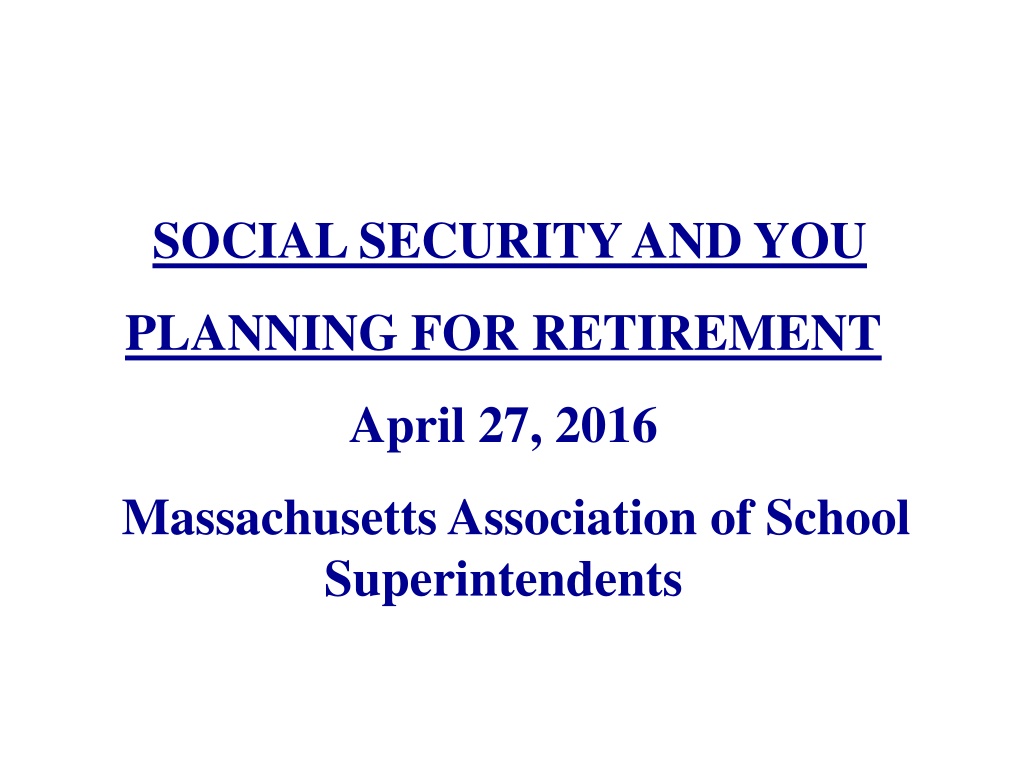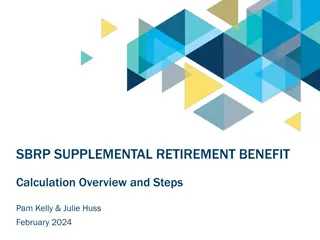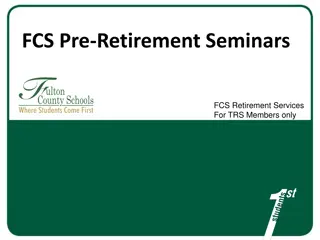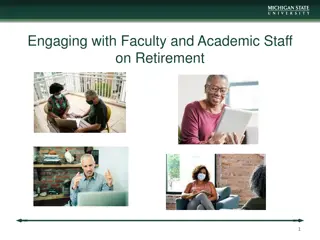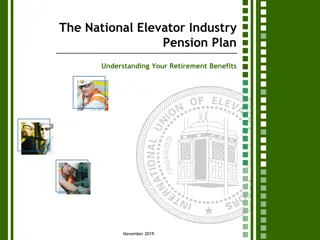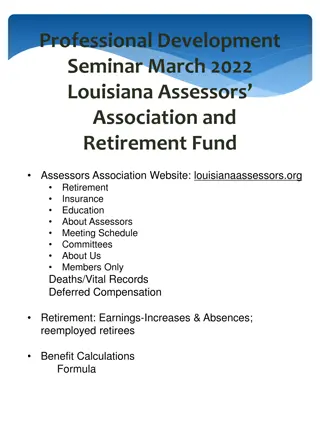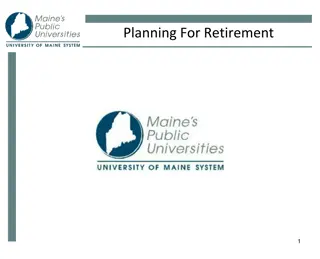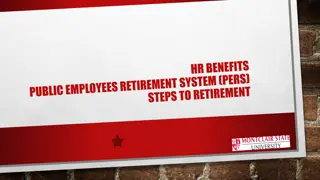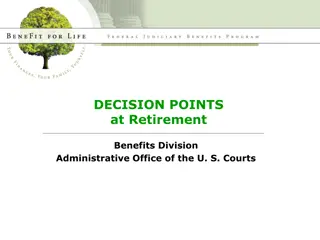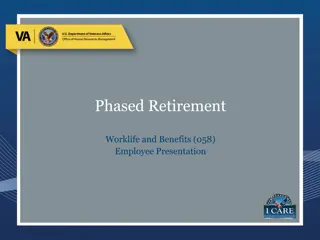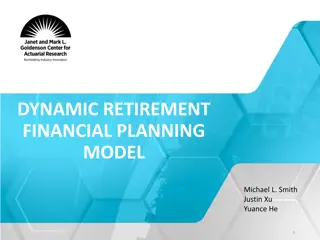Planning for Retirement with Social Security
Discover how Social Security can impact your retirement planning, including benefits such as Retirement Insurance, Survivors Insurance, and Medicare. Learn about creating a personal Social Security account, understanding non-covered pensions, and managing your benefits effectively.
Download Presentation

Please find below an Image/Link to download the presentation.
The content on the website is provided AS IS for your information and personal use only. It may not be sold, licensed, or shared on other websites without obtaining consent from the author.If you encounter any issues during the download, it is possible that the publisher has removed the file from their server.
You are allowed to download the files provided on this website for personal or commercial use, subject to the condition that they are used lawfully. All files are the property of their respective owners.
The content on the website is provided AS IS for your information and personal use only. It may not be sold, licensed, or shared on other websites without obtaining consent from the author.
E N D
Presentation Transcript
SOCIAL SECURITY AND YOU PLANNING FOR RETIREMENT April 27, 2016 Massachusetts Association of School Superintendents
The Package of Protection (1935) Retirement Insurance (1939) Survivors Insurance (1956) Disability Insurance (1965) Medicare (Part A) (1972) Supplemental Security Income * *administered by SS but not paid with F.I.C.A taxes
A Foundation for Planning Your Future OTHER INCOME SAVINGS & INVESTMENTS PENSION SOCIAL SECURITY
For Those with Careers in the Public Sector OTHER INCOME SAVINGS & INVESTMENTS SOCIAL SECURITY NON-COVERED PENSION
What You Need to Know How to create a Social Security personal account Understand how your non covered pension affects your Social Security benefits Understand any changes in Social Security Understand when to contact Social Security Be familiar with what you can do online
Who Can Open a my Social Security Account You must be at least 18 years old and have a: Valid E-mail address Social Security number and U.S. mailing address.
Why open an Account View, save, and print your Social Security Statement Verify your lifetime F.I.C.A. earnings according to Social Security s records for accuracy Review Medicare taxes you ve paid Learn about qualifying and signing up for Medicare Protect your Social Security number!
What Else can my Social Security Offer When you receive benefits, you can: Check your benefit and payment Verify your earnings record Change your address and phone number Change your direct deposit Request a new Medicare card Request a 1099
The Benefit Basics For everyone there are 3 core elements to retirement: 1. VESTING 2. CALCULATING 3. THE 100% FULL RETIREMENT AGE
Qualifying for Social Security Retirement Vesting for retirement is determined by work paid into the cash portion of F.I.C.A. Earning 40 credits (10 years of cumulative work) is qualifying for a Social Security retirement benefit. Earning credits in a calendar year is measured by a monetary amount that usually changes annually. In 2016 one credit is earned for every $1,260 earned, never to exceed 4 credits ( $5040 for 4 credits).
CALCULATING THE RETIREMENT BENEFIT There are 3 steps to the calculation. Step 1: Wages are adjusted for changes in wage levels over time (indexing). Step 2: Find the monthly average of the 35 highest earnings years. Step 3: The result is the average indexed monthly earnings .
Full Retirement Age Year of Birth Full Retirement Age 1937 or earlier 1938 1939 1940 1941 1942 1943 1954 1955 1956 1957 1958 1959 1960 or later 65 65 & 2 months 65 & 4 months 65 & 6 months 65 & 8 months 65 & 10 months 66 66 & 2 months 66 & 4 months 66 & 6 months 66 & 8 months 66 & 10 months 67
The Effect of Non Covered Pensions on Social Security Windfall Elimination Provision may be imposed for Social Security retirement benefits Government Pension Offset may be imposed for spousal life and death benefits.
Those Who Will Be Affected Public employees who receive a monthly retirement allowance from the Comm. of MA or a local government Public employees in MA who receive an annuity as a primary payout ( 457 plans) Social Security refers to these pensions as non covered . *MA is one of 15 states that does not contribute to Social Security. Spouses who receive a survivor allowance from a public employee are not affected.
Windfall Elimination Provision This applies to those who receive a non-covered pension and are also vested for their own Social Security retirement benefit. The Windfall provision pays a lower retirement benefit by using a formula change but the retirement benefit will never be eliminated. ( The Windfall 100% benefit can never be reduced by more than your non-covered pension amount.)
Exceptions to the Windfall Age 62 by 1/86 Eligible for non-covered pension by 1/86 Have 30 year of what Social Security considers substantial earnings . If these exceptions don tapply, the WEP formula change will be imposed and you will receive a lower Social Security payment than what The Statement shows.
Definition of Substantial Earnings Social Security has determined an exact dollar amount to be substantial for each calendar year. If you earned at least that amount or more in that year, you have a substantial earnings year . If you total 30 or more of these years, your retirement benefit will not be affected. If you have 21-29 of these years, your retirement benefit is not lowered as much.
Substantial Earnings 37-54 $900 55-58 $1,050 59-65 $1,200 66-67 $1,650 68-71 $1,950 1972 $2,250 1973 $2,700 1974 $3,300 1975 $3,525 1976 $3,825 1977 $4,125 1978 $4,425 1979 $4,72 1980 $5,100 1981 $5,550 1982 $6,075 1983 $6,675 1984 $7,050 1985 $7,425 1986 $7,875 1987 $8,175 1988 $8,400 1989 $8,925 1990 $9,525
Substantial Earnings (cont.) 2003 2004 2005 2006 2007 2008 09- 11 $19,800 2012 $20,475 2013 $21,075 2014 $21,750 2015, 16 $22,050 $16,125 $16,275 $16,725 $17,475 $18,150 $18,975 1991 $9,900 1992 1993 1994 1995 1996 1997 1998 1999 2000 $14,175 2001 2002 $15,750 $10,350 $10,725 $11,250 $11,325 $11,625 $12,150 $12,675 $13,425 $14,925
Government Pension Offset This provision impacts individuals who are eligible for Social Security benefits based upon a living or deceased spouse s work and the spouse receives a non covered pension. Social Security applies a formula that will reduce the spousal payment by 2/3 of the monthly public pension amount. GPO could eliminate Social Security completely for spouses.
Government Pension Offset Example Spouse receives a public pension of $900 per month Spouse would otherwise be entitled to $500 per month from Social Security as a spouse Because 2/3 of $900 is $600 and $600 is greater than $500, no spousal benefits will be paid.
How Public Pension COLAs Affect Social Security Benefits Those affected by WEP: Changes in pension amount will not affect the initial WEP calculation. Those affected by GPO: A change in the monthly pension amount such as periodic cost of living adjustments will affect the pension amount.
How to Determine Your WEP/GPO Benefit 1. Go to socialsecurity.gov 2. Go to Benefits on the toolbar 3. Click on Government Employees 4. Click Windfall Calculator 5.Click Govt. Pension Offset Calculator
When WEP and GPO will Not Apply These provisions ONLY APPLY when the non-covered pension is being received. Until someone begins to draw the non-covered pension, Social Security does not adjust the benefits! When a worker reaches full retirement age and is still working in the public sector position, the full Social Security benefit is payable without imposing WEP or GPO because: There is no earnings limitation at full retirement age
Earnings Limitations Before FRA Under Full Retirement Age Year $15,720/yr. ($1,310/mo.) $1 for every $2 earned will be withheld from benefits payable, if the earnings limit is exceeded. The Year Full Retirement Age is Reached $ 41,880/yr. ($3,490/mo.) $1 for every $3 will be withheld from benefits payable, if the earnings limit is exceeded. From the month of Full Retirement Age there is no earnings limitation.
Age at Retirement Determines the Amount If you retire based on your own work credits: At age 62, you get a lower monthly payment At your full retirement age, you get your full benefit You get an even higher monthly payment if you delay your benefits past full retirement age
For Full Retirement Age of 66 For example, if you were born from 1943 through 1954: Age 62 Age 66 Age 70 75% of benefit 100% of benefit 132% of benefit Amounts are calculated precisely to the month benefits begin.
Eligible Dependents of the Retiree Children Not married under 18 (under 19 if still in high school) Disabled young adult Disabled before age 22 Unmarried
Spousal Benefits Current Spouse Age 62 or older At any age, if caring for a child under age 16 or disabled Worker must be receiving benefits Your Ex-Spouse Ex-spouse 62 or older Marriage lasted at least 10 years, not remarried ( If divorce has been in effect at least two years, ex-spouses can receive benefits regardless of the worker s benefit status) Ex-spouse s benefits have no effect on the current spouse s benefits
Spousal Benefit Amounts 50% of worker s unreduced benefitat spouse s full retirement age The 50% is reduced for early retirement If spouse s own benefit is less than the worker s 50%, the highest combination is paid. Payments to worker are never affected There are/were financial strategies for spouses and workers
Ways To Apply for Retirement/Spousal Benefits Apply online at www.socialsecurity.gov It is the most convenient way to apply or Call Social Security to schedule an appointment 1-800- 772-1213 (TTY 1-800-325-0778); or Apply at your local Social Security office. You should file approximately 3 months before the month you want benefits to begin.
Eligibility for Survivors Benefits Children: Not married under age 18 (under 19 if still in high school) Not married an disabled before age 22 Widows/Widowers: If disabled as early as age 50 At any age if caring for child under 16 or disabled Divorced widows/widowers may qualify Remarriage after age 60 (50 if disabled)
Widow or Widower Benefit Computation At full retirement age, 100% of deceased worker s unreduced benefit is paid. The 100% is reduced for age to approximately 71.5% of deceased worker s unreduced benefit at age 60 (reduced proportionately between FRA and age 60 on a month by month adjustment). Options for survivor benefits and also benefits based on the survivor s own work and earnings at different times exists. This also applies to divorced widows and widowers.
How Financial Strategies Evolved The lifting of the earnings limit at full retirement age , allowed individuals to collect Social Security while still working, regardless of how much they earned. Creative strategies came about to maximize a couple s retirement options. These applied to workers and spouses who were both at least full retirement age . There were no Social Security laws addressing these strategies until the Bipartisan Act of 2015.
What Were the Financial Strategies The strategies were: 1. File @ FRA, receive 100%, withdraw and refund and reapply at age 70 (100% + delayed credits) 2. File and Suspend 3. Spouse then Worker (Deemed Filing)
Closing the Loopholes What has Changed Strategy #1- File, withdraw, reapply: This loophole was closed about 7 years ago Current rules reverts to the law as it was; that one must withdraw an application within 12 months of starting Social Security retirement benefits.
Closing the Loopholes Strategy #2- File and Suspend: The provision to close this loophole takes effect April 30, 2016. After that date, if a worker suspends, then spousal benefits will also be suspended. This rule reverts back to Social Security law as it existed before.
Closing the Loophole Strategy #3- Spouse then Worker: This loophole is no longer available to anyone who was not age 62 or over prior to January 2, 2016. Anyone who is at least age 62 in 2015 can still file a restricted claim for spousal from full retirement age and delay their own until age 70. The worker, however, must be receiving benefits.
Who is not Affected by the Changes Independently entitled divorced spouses Surviving spouses Why they are not affected: The laws for beneficiaries in these categories did not change as a result of the strategies.
Eligibility for Disability Benefits Worker Must have paid into Social Security five out of last 10 years For younger workers, under age 31 less work is required If your most recent work is in a non covered system, you may not qualify for Social Security disability.
Medicare Eligibility 65 & older -or- 24 months after entitlement to Social Security disability benefits -or- Amyotrophic Lateral Sclerosis -or- Permanent kidney failure and receive maintenance dialysis or a kidney transplant -or- Exposure to Environmental Health Hazards
Medicare Coverage Part A - Hospital Insurance Covers most inpatient hospital expenses 2016 Deductible $1,288 Part B - Medical Insurance Covers 80% doctor bills & other outpatient medical expenses after 1st $166/year in approved charges 2016 Standard Monthly Premium $121.80 Part D - Medicare Prescription Drug Plan Covers a major portion of prescription drug costs for Medicare beneficiaries.
Who is Eligible for Free Part A Individuals with 40 credits under Social Security Individuals who do not have 40 credits but are a spouse, ex-spouse, widow/widower of a worker who has 40 credits. Non-covered employees who paid into Medicare only for 10 years (1.45% of F.I.C.A. taxes) ** Anyone can purchase Part B!
Medicare B Income Related Monthly Adjusted Amount ( IRMAA ) Single Married filing jointly Less than or equal to $170K >$170K up through $214K >$214K up through $320K >$320K up through $428K Greater than $428K Total monthly Premium $121.80 Less than or equal to $85K >$85K up through $107K >$107K up through $160K >$160Kup through $214K Greater than $214K $170.50 $243.60 $316.70 $389.80
There Are 3 Enrollment Periods INITIAL ENROLLMENT SPECIAL ENROLLMENT GENERAL ENROLLMENT
Initial Enrollment Period This is your age 65 window File 3 months prior to your 65th birthday month to be effective the first day of the month you turn 65. This applies to those not working with an employer plan at 65, Those not covered under a working spouse s plan
Special Enrollment Period An active employee or spouse of an employee covered by employer group health plan will remain on the employer plan as primary beyond age 65 in most cases. A special enrollment is is an 8 month window, which begins the month active employment or active coverage criteria ends. This enrollment does not hold a penalty for filing after age 65. There is no lapse in coverage from active to retiree status.
Special Enrollment Period (cont.) Your employer is asked to complete a form to verify the active coverage dates. Part B should be initiated 2-3 months before the date of change from active to retiree so that coverage will be in place timely.** **If you are not on Part A at the time, you will need to file for both Parts A and B by completing a full application with SSA.
General Enrollment Period A GEP occurs each Jan. through March for individuals who missed an initial or special enrollment. The coverage begins July 1st of that year. A penalty of 10% is imposed for each year you should have applied for Part B, but did not. The penalty is added to the base premium that year and remains for life!
What do I do now if I retired from the State/local before age 65 and carry my health insurance as a retiree. I am approaching age 65 You must file for both Part A and B within 3 months of your 65th birthday month. Medicare is effective on the 1st day of the month you turn 65. You ll be billed quarterly until you begin to receive Social Security payments. If you are already collecting SS when you are 65, Medicare is automatic and Social Security will notify you about 4 months before your 65th birthday!
